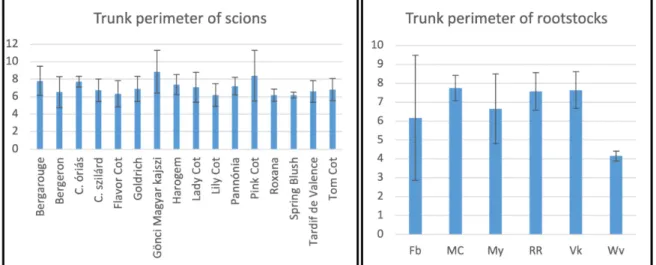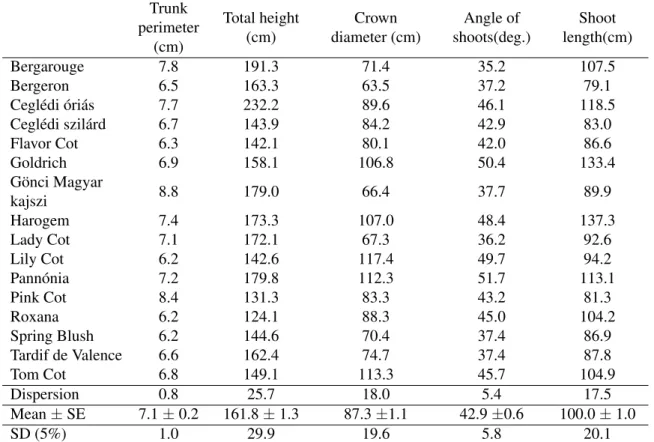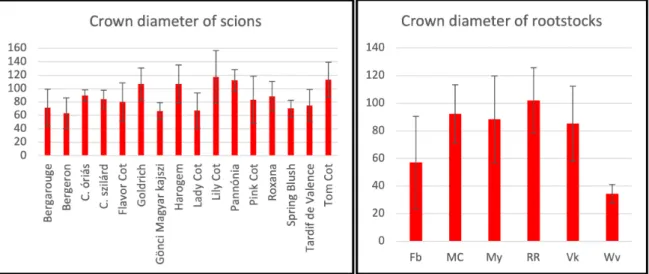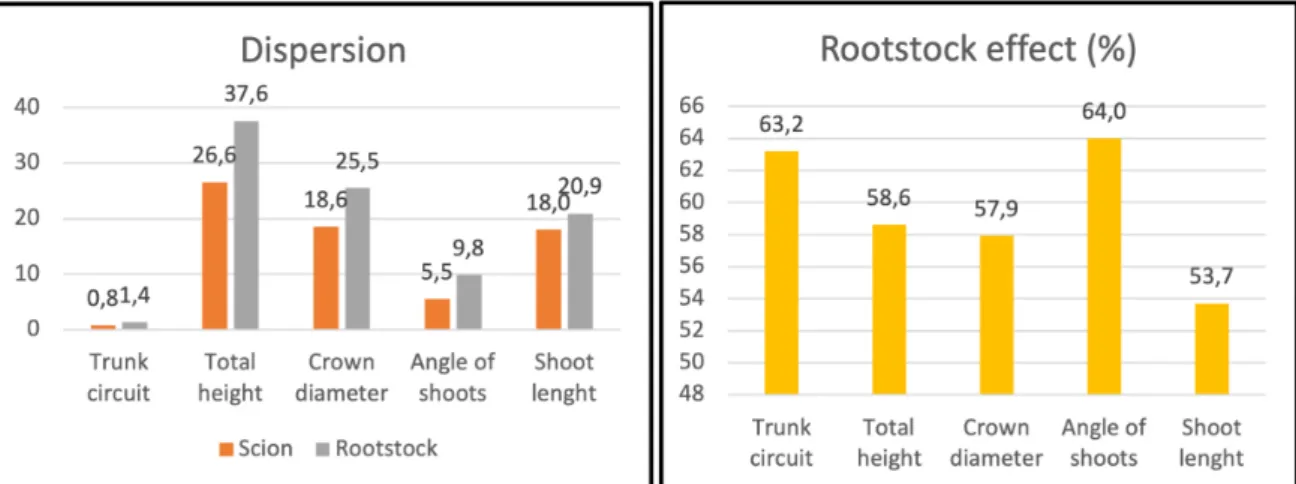Vegetative growth of apricot (P. armeniaca L.) cultivars and rootstocks
Edina PÁSZTI MENDELNÉ1– Ákos MENDEL1
1: National Agricultural Research and Innovation Centre, Research Institute for Fruitgrowing and Ornamentals, Hungary, 1223 Budapest, Park utca 2., e-mail: mendel.akos@uni-mate.hu
Abstract: The continuous innovation in point of apricot cultivars and rootstocks requires comparative tri- als, which can be evaluated by precise measurements. An experiment is established, initiated from the recent trends. 15 scion cultivars were budded on 6 different rootstock cultivars. Apricot seedling, Montclar, My- robalan 29C, Wavit, Rootpack R and Fehér besztercei were used as rootstock. Scions included traditional Hungarian cultivars (Gönci Magyar kajszi, Ceglédi óriás, Ceglédi szilárd, Pannónia), naturalized cultivars (Bergeron, Roxana) and modern cultivars too (Goldrich, Tardif de Valence, LadyCot, FlavorCot, PinkCot, Spring Blush). The experiment was settled at spring of 2018, with 3⇥5 m spacing. Sprouting was 98%, the deficiency was originated only from fawn damage. The main effect of the different rootstocks can be observed in the growth habit of scions, meanwhile the scion cultivar also has a moderate impact.
Keywords: Apricot, vegetative growth, rootstock, scion
Received 23 May 2020, Revised 6 October 2020, Accepted 10 October 2020
Introduction
The beneficial properties of a rootstock can predominate in the orchard in two different ways: On the one hand, when the rootstock cultivar (composing the root system and/or the trunk) provides its attributes to the com- plete engraftment. The rootage of the root- stock is responsible for the water- and nutri- ent uptake, and for the acclimatization to the different ecological conditions. Capability of growing a stable trunk with good fitness of the trunk-training rootstock pertains here. On the other hand, predomination manifests it- self in the stock and scion interaction. The rootstock affects the vegetative and genera- tive performance of the scion, like the pro- ductivity, time of fruiting, growth rate, the quality and storability of fruits (Hrotkó 1999;
Darikova et al., 2011).
Advantage of the engraftment is securing the phenological phases, and the quicker reach-
ing of productive status. Main benefit of the engraftment is the mass production at a mod- erate cost (Küppers 1978; Hrotkó 1999).
According to Szani et al. (2006), the most used rootstocks for apricot growing are apri- cot seedlings selected at Cegléd (C.1301, C1650 and C.1652). These are fully compat- ible with all of the scion varieties, but remain between the limits of the species.
At evaluation of monumental rootstock ex- periments, Southwick and Weis (1998) con- cluded, that using some myrobalan root- stocks increases the mortality of apricot trees with higher rates, than those from other species. It was considered as latent (incom- plete) incompatibility. Though several re- searches were realized in case of apricot rootstocks, these results cannot be general- ized (Miloševi´c et al., 2014, Milatovi´c et al., 2017). We have to find those scion-stock combinations which are suitable in our grow- ing region (Oprita and Gavat, 2018).
Materials and Methods
The trial was situated at the Research Station of Cegléd, Research Institute for Fruitgrow- ing and Ornamentals, National Agricultural Research and Innovation Center. The region has a temperate, continental climate with a semi-arid microclimate. This area is not op- timal for apricot growing, however the one third of Hungarian apricot fields are situated in similar locations. The altitude is 96 me- ters above see-level. The surface is plain with some local differences (by 1-2 meters). The experimental orchard can be approached on concrete road, and has a fence around it.
The orchard was planted in spring of 2018 in 3*5 m spacing, living mulch between the rows were sod with grass at the same autumn. The irrigation is not resolved yet.
Pruning is performed several times a year, such as foliar fertilization. Plant protection is outstandingly respected. Every scion-stock combination is pleaded by three trees per replicates, two replicates are settled. Repli- cates are situated at a totally random ar- rangement, none of the rootstocks, nor the scions have the same neighbor. In case of scions, traditional Hungarian cultivars, French, Spanish, Italian, Canadian and also afghani cultivars are represented. Used culti- vars are summarized in Table 1.
Further back Fehér besztercei was used ex- pansively in Hungary as a generatively prop- agated apricot rootstock, but it shows some incompatibility with the cultivars, therefor Apricot seedling is commonly used. In the last decade, Myrobalan 29C came into use, and Wavit is in raising amongst others. Used rootstock cultivars are summarized in Table 2. All of the 16 scion cultivars were grafted onto every mentioned rootstock cultivar.
Data collected at the autumn of the first growing season (2018) is represented in this study. Trunk perimeter and shoot length were measured by measuring-tape (mm ac- curately), crown diameter and total height
were specified by measuring-rod (dm accu- rately). The angles of the shoots were cal- culated from the crown diameter and shoot length by the following equation:
sin 1(crown diameter 2⇥shoot length)
Results and Discussion
In this experiment the perimeter of trunks at 35 cm height, the length and angles of shoots, the diameter of crowns and the total height of the trees were investigated. Aver- age of two replicates presented, each repli- cate contained three individuals. Figure 1.
shows the average of trunk perimeter by scion and rootstock cultivars.
The averages of trunk perimeters were be- tween 6.2 and 8.8 cm one year after plan- tation, their average was 7.1 cm. The high- est value belonged to the Gönci Magyar kajszi (8.8 cm), followed by PinkCot and Bergarouge. Roxana, LilyCot and Spring Blush had the smaller perimeter, evenly 6.2 cm. In the aspect of rootstock cultivars, data of trunk perimeter ranges from 4.2 cm (Wavit) to 7.7 cm (Montclar), with a total av- erage of 6.7 cm. Figure 2. shows the average shoot lengths.
In case of shoot lengths, higher differences were observable. At the first season Harogem (137 cm) Goldrich (133 cm) and Ceglédi óriás (118 cm) had the largest growth. The smallest enlargement belonged to Bergeron (79 cm), followed by PinkCot (81 cm) and Ceglédi szilárd (83 cm). Average shoot length was 100 cm. Per rootstocks, Wavit had the smallest growth (54 cm). Fehér beszter- cei (81 cm), Apricot seedling (94 cm), My- robalan 29 C (95 cm), Montclar (108 cm) and Rootpack R (111 cm) was the ranking. Aver- age shoot length of the rootstocks was 91 cm.
Figure 3. shows the angles of the shoots.
To establish of a good income with a more intensive apricot orchard, it is essential to know the space demand of the different scion
Table 1. Used scions and their state of origin Scion cultivar State of origin
Ceglédi óriás Hungary
Ceglédi szilárd Hungary Gönci Magyar kajszi Hungary
Pannónia Hungary
FlavorCot USA
Goldrich USA
LillyCot USA
Spring Blush USA
TomCot USA
Bergeron France
Bergarouge France
LadyCot France
PinkCot France
Tardif de Valence Italy
Harogem Canada
Roxana Afghanistan
Table 2. Used rootstock cultivars, their species and propagation
Rootstock cultivar Species Propagation
Fehér besztercei (Fb) Prunus domesticaL. generatively/vegetatively
Montclar (MC) Prunus persicaL. vegetatively
Myrobalan 29C (My) Prunus cerasifera myrobalanaEhrh. vegetatively Rootpack R (RR) P. cerasifera myr.⇥P. dulcisMill. vegetatively Apricot seedling (As) Prunus armeniacaL. vegetatively
Wavit (Wv) Prunus domesticaL. vegetatively
and rootstock cultivars (Gliši´c et al., 2014).
Highest angles were observed at Pannónia (52°), LilyCot (50°) and Goldrich (50°).
Steepest shoots were grown on Bergarouge (35°), LadyCot (36°) and Bergeron (37°).
Average angle of shoots was 43° to verti- cal after the first season. When data was ob- served by rootstock cultivars, major differ- ences remarked. Regressive sequentially the following angles were calculated: Rootpack R (47°), Montclar (45°), Myrobalan 29 C (44°), Apricot seedling (44°), Fehér beszter- cei (32°), Wavit (22°). Average shoot-angle
of the rootstock cultivars 39° to the vertical.
Figure 4. shows the diameter of crowns of the combinations.
Crown diameters had a very large range af- ter the first year, when the average of the scions was 87 cm. LilyCot (117 cm), Tom- Cot (113 cm), Pannónia (112 cm) was the ranking. The narrowest cultivars were Berg- eron (64 cm), Gönci Magyar kajszi (66 cm) and LadyCot (67 cm). In the aspect of root- stock cultivars, even larger differences were observable. The widest crown belonged to Rootpack R (102 cm), followed by Montclar
Figure 1. Average trunk perimeter by scion and rootstock cultivars at 35 cm height (cm).
Figure 2. Average shoot lengths by scion and rootstock cultivars (cm).
(92 cm), and Myrobalan 29 C (88 cm). After this Apricot seedling came by 85 cm. Fehér besztercei (57 cm) and Wavit (34 cm) root- stocks had the two smallest crowns. Their av- erage width was 77 cm. Figure 5. shows the total height, including the 80 cm of the trunk too.
The height of Ceglédi óriás exceeded of the scion cultivars with its average 232 cm It was followed by Bergarouge (191 cm), Pannó- nia (180 cm) and Gönci Magyar kajszi (179 cm). Lowest trees were in average of Rox- ana (124 cm), PinkCot (131 cm) and Lily-
Cot (143 cm). Average of tree height was 162 cm in total. Amongst the rootstock cul- tivars Rootpack R was the highest (187 cm), followed by Montclar (186 cm) and Apricot seedling (179 cm). The sequence continued with Myrobalan 29 C (140 cm), Wavit (112 cm) and Fehér besztercei (105 cm). In divi- sion of rootstocks, the average of tree heights was 150 cm. Total height of trees is smaller in average than Ognjanov et al. (2018) found in Serbia due to more drained soil conditions.
Table 3. and Figure 6. show the dispersion of the previously described values. Trunk
Table 3. Trunk perimeter, total height, crown diameter, angle of shoots and shoot length of scion cultivars
Trunk Total height
(cm) Crown
diameter (cm) Angle of
shoots(deg.) Shoot length(cm) perimeter
(cm)
Bergarouge 7.8 191.3 71.4 35.2 107.5
Bergeron 6.5 163.3 63.5 37.2 79.1
Ceglédi óriás 7.7 232.2 89.6 46.1 118.5
Ceglédi szilárd 6.7 143.9 84.2 42.9 83.0
Flavor Cot 6.3 142.1 80.1 42.0 86.6
Goldrich 6.9 158.1 106.8 50.4 133.4
Gönci Magyar 8.8 179.0 66.4 37.7 89.9
kajszi
Harogem 7.4 173.3 107.0 48.4 137.3
Lady Cot 7.1 172.1 67.3 36.2 92.6
Lily Cot 6.2 142.6 117.4 49.7 94.2
Pannónia 7.2 179.8 112.3 51.7 113.1
Pink Cot 8.4 131.3 83.3 43.2 81.3
Roxana 6.2 124.1 88.3 45.0 104.2
Spring Blush 6.2 144.6 70.4 37.4 86.9
Tardif de Valence 6.6 162.4 74.7 37.4 87.8
Tom Cot 6.8 149.1 113.3 45.7 104.9
Dispersion 0.8 25.7 18.0 5.4 17.5
Mean±SE 7.1±0.2 161.8±1.3 87.3±1.1 42.9±0.6 100.0±1.0
SD (5%) 1.0 29.9 19.6 5.8 20.1
Figure 3. Included angle of shoots to vertical by scion and rootstock cultivars (deg.).
perimeter, total height, crown diameter, an- gle of shoots and shoot length of scion cul- tivars, their mean values, the dispersion, the
SE and SD values can be observed there.
Evaluating the data shows, the higher value of an attribute, the higher is the disperse
Figure 4. Average crown diameters by scion and rootstock cultivars (cm).
Figure 5. Average total height by scion and rootstock cultivars (cm).
of it. This property of the analysis comes from the recording of data, and is not con- sidered as a scientific achievement in this experiment. However, it can be seen that in every measured attribute the dispersion be- tween rootstock cultivars were higher than between scions. Percental fraction of distri- butional values of the rootstocks were es- tablished from these data. 63.2% of trunk perimeter, 58.6% of total height, 57.9% of crown diameter, 64% of angle of shoots, 53.7% of shoot length depends on the cul- tivar of rootstock.
Conclusions
1000 apricot trees were planted from 96 combination of 6 rootstock and 16 scion cul- tivars. Data were collected from 5 properties which describe well the vegetative growth of an engraftment. Scion cultivars represents the cultivar preferences in Hungary, while there are less used rootstock cultivars (Root- pack R, Montclar) in this trial too.
Highly vigorous rootstocks are Montclar and Rootpack R, these cultivars had the highest values in all cases. Apricot seedling and My-
Figure 6. Dispersion of data divided by scion and rootstock cultivars, and fraction of root- stocks of dispersion (%).
robalan 29 C can be typified with moder- ate growth habit with very similar character- istics. Weak growth was observed at Fehér besztercei and Wavit rootstocks. Wavit root- stock cultivar had the lowest parameters in every case. Here, it had to be declared, that our non-irrigated circumstances are not ideal for this last two rootstocks (for they plum ori- gin).
In case of scion cultivar, it is harder to make up discrete categories like previously.
Some parameters are not in strong corre- lation with others, but differences can be observed here too. As a general princi- ple vigorous growth typifies the Ceglédi óriás, Pannónia, Goldrich, Harogem, Tom- Cot and Bergarouge cultivars. Roxana, PinkCot, Ceglédi szilárd and Spring Blush
cultivars appeared with expressly weak growth. The other cultivars positioned be- tween this two separate groups.
It appears unequivocally, that the rootstock cultivars give the bigger portion of the dif- ferences of growth habit in this experiment, therefor it has to be a very important element of the planning of a growing system. Vigor- ously growing rootstocks are suitable for re- planting or refilling apricot trees, while weak rootstocks are only acceptable with proper irrigation and fertilization for ensuring the lower spacing in the orchard. Besides this, scion cultivars responsible for important dif- ferences (36-46%). Accordingly, if other fac- tors permit, the vegetative growth could also be an aspect of choosing a cultivar.
References
Darikova, J. A., Savva, Y.V., Eugene, A., Vaganov, E. A., Grachev, A.M., Kuznetsova, G.V.
(2011): Grafts of woody plants and the problem of incompatibility between scion and rootstock (a review). Journal Siberian Federal University. Biology 4:54–63
Gliši´c I., Miloševi´c T., Miloševi´c N., Nikoli´c R., Paunovi´c G., (2014): Agroeconomic analysis of apricot production in early years after planting. Fifth International Scientific Agricultural Sympo- sium „Agrosym 2014“
Hrotkó, K. (1999): Gyümölcsfaiskola. Mez˝ogazda Kiadó, Budapest
Küppers, H. (1978): Problematik der VeredlungsunterlagenfürSauer- und Süsskirschen in Spiegel von 250 Jahren. Deutsche Baumschule. 11: 350-359.
Milatovi´c D., Keserovi´c Z., Miloševi´c T. (2017): Savremeni sortiment i tehnologija gajenja ka- jsije. Savetovanje „Savramena proizvodnja vo´ca”, 50 godina ˇcasopisa „Vo´carstvo”, zbornik apstrakta, Banja Koviljaˇca, pp. 23-26.
Miloševi´c, T., Miloševi´c, N., Gliši´c, I. (2014): Apricot Vegetative Growth, Tree Mortality, Productivity, Fruit Quality and Leaf Nutrient Composition as Affected by Myrobalan Rootstock and Blackthorn Inter-Stem. Erwerbs-Obstbau. 57: 77-91. https://doi.org/10.1007/s10341-014-0229-z
Ognjanov V., Ljubojevi´c M., Bara´c G., Duli´c J., Miodragovi´c M., Narandži´c T. (2018): Apricot rootstock breeding at the Faculty of Agriculture, Novi Sad. Journal of Pomology, 52, 203-204, 107- 113.
Oprita V.A., Gavat C. (2018): Behavior of some apricot cultivars grafted on new vegetative rootstocks. Scientific Papers. Series B, Horticulture, 62: 115-117.
Southwick, S.M., Weis, K. G. (1998): Selecting and propagating rootstocks to produce apri- cots. Horticultural Technology 8: 164–170. https://doi.org/10.21273/HORTTECH.8.2.164
Szani Z., Vincek K., Erdos Z., Vegvari G., Szabo Z. (2006): Morphological examination of Hungarian apricot rootstock varieties. International Journal of Horticultural Science, 12(3): 59-63.
https://doi.org/10.31421/IJHS/12/3/660




